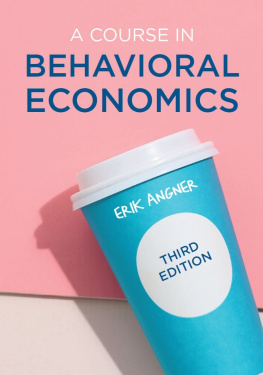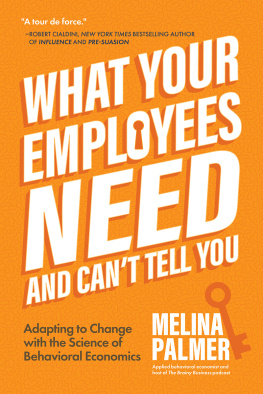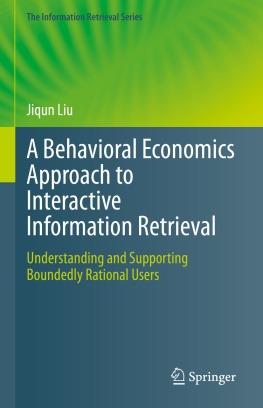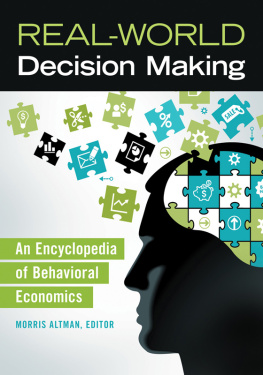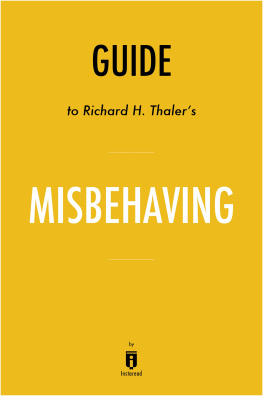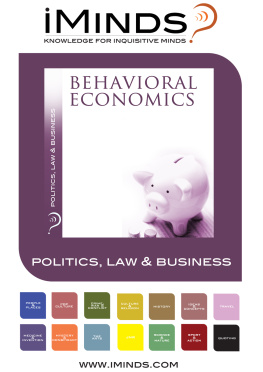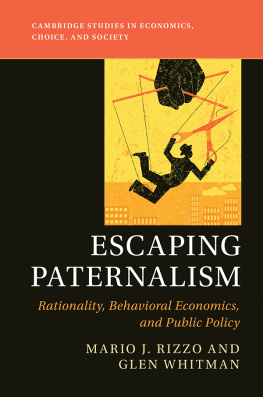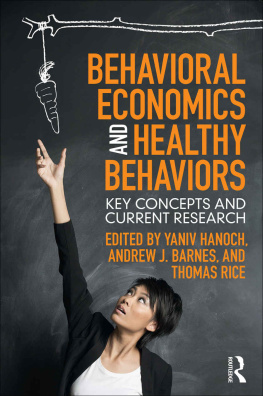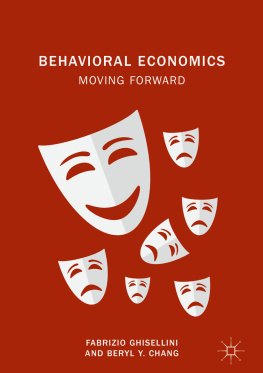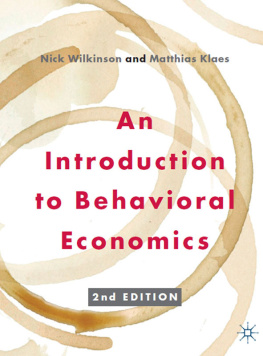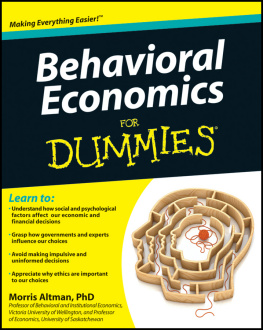Erik Angner - A Course in Behavioral Economics
Here you can read online Erik Angner - A Course in Behavioral Economics full text of the book (entire story) in english for free. Download pdf and epub, get meaning, cover and reviews about this ebook. year: 2021, publisher: Red Globe Press, genre: Politics. Description of the work, (preface) as well as reviews are available. Best literature library LitArk.com created for fans of good reading and offers a wide selection of genres:
Romance novel
Science fiction
Adventure
Detective
Science
History
Home and family
Prose
Art
Politics
Computer
Non-fiction
Religion
Business
Children
Humor
Choose a favorite category and find really read worthwhile books. Enjoy immersion in the world of imagination, feel the emotions of the characters or learn something new for yourself, make an fascinating discovery.
- Book:A Course in Behavioral Economics
- Author:
- Publisher:Red Globe Press
- Genre:
- Year:2021
- Rating:4 / 5
- Favourites:Add to favourites
- Your mark:
- 80
- 1
- 2
- 3
- 4
- 5
A Course in Behavioral Economics: summary, description and annotation
We offer to read an annotation, description, summary or preface (depends on what the author of the book "A Course in Behavioral Economics" wrote himself). If you haven't found the necessary information about the book — write in the comments, we will try to find it.
A Course in Behavioral Economics — read online for free the complete book (whole text) full work
Below is the text of the book, divided by pages. System saving the place of the last page read, allows you to conveniently read the book "A Course in Behavioral Economics" online for free, without having to search again every time where you left off. Put a bookmark, and you can go to the page where you finished reading at any time.
Font size:
Interval:
Bookmark:

A Course in
Behavioral Economics
A Course in
Behavioral Economics
ERIK ANGNER
Third edition

Erik Angner, under exclusive licence to Macmillan Education Limited 2012, 2016, 2021
All rights reserved. No reproduction, copy or transmission of this publication may be made without written permission.
No portion of this publication may be reproduced, copied or transmitted save with written permission or in accordance with the provisions of the Copyright, Designs and Patents Act 1988, or under the terms of any licence permitting limited copying issued by the Copyright Licensing Agency, Saffron House, 610 Kirby Street, London EC1N 8TS.
Any person who does any unauthorized act in relation to this publication may be liable to criminal prosecution and civil claims for damages.
The author has asserted their right to be identified as the author of this work in accordance with the Copyright, Designs and Patents Act 1988.
This edition published 2021 by
RED GLOBE PRESS
Previous editions published under the imprint PALGRAVE
Red Globe Press in the UK is an imprint of Macmillan Education Limited, registered in England, company number 01755588, of 4 Crinan Street, London, N1 9XW.
Red Globe Press is a registered trademark in the United States, the United Kingdom, Europe and other countries.
ISBN 978-1-352-01080-0 paperback
This book is printed on paper suitable for recycling and made from fully managed and sustained forest sources. Logging, pulping and manufacturing processes are expected to conform to the environmental regulations of the country of origin.
A catalogue record for this book is available from the British Library.
A catalog record for this book is available from the Library of Congress.
To Iris
The master-piece of philosophy would be to develop the means which Providence employs to attain the ends it proposes over man, and to mark out accordingly a few lines of conduct which might make known to this unhappy biped individual the way in which he must walk within the thorny career of life, that he might guard against the whimsical caprices of this fatality to which they give twenty different names, without having as yet come to understand or define it.
The Marquis de Sade, Justine
As a Ph.D. student in economics, behavioral economics struck me as the most exciting field of study by far. Even with the benefit of some spectacular teachers, though, I felt that existing literature failed to convey an adequate understanding of the nature and significance of the project, and how the many different concepts and theories described as behavioral were tied together. When as an assistant professor I was offered the opportunity to teach my own course, I discovered that there were few texts available in the sweet spot between popular-science treatments, which do not contain enough substance for a university-level course, and scientific papers and more advanced textbooks, which are not easily readable and typically fail to provide sufficient background to be comprehensible to a novice reader.
This introduction to behavioral economics was written to be the book I wish I had had as a student, and the book that I want to use as a teacher. It aspires to situate behavioral economics in historical context, seeing it as the result of a coherent intellectual tradition; it offers more substance than popular books but more context than original articles; and while behavioral economics is a research program as opposed to a unified theory, the book not only describes individual concepts and theories but also tries to show how they hang together. The book was designed as a user-friendly, self-contained, freestanding textbook suitable for a one-semester course at the undergraduate level, but can easily be used in conjunction with books or articles in a variety of higher-level courses and programs.
In recognition of the fact that many students of behavioral economics come from outside traditional economics, the exposition was developed to appeal to advanced undergraduates across the social and behavioral sciences, humanities, business, public health, etc. The book contains no advanced mathematics and presupposes no knowledge of standard economic theory. If you are sufficiently interested to pick up a copy of this book and read this far, you have what it takes to grasp the material. Thorough battle-testing at two medium-sized state universities in the US over the course of several years has confirmed that the treatment is accessible to diverse audiences including to economics majors and non-majors alike.
Serious economics does not need to be intimidating, and this book aims to prove it. Abstract, formal material is introduced in a progressively more difficult manner, which serves to build confidence in students with limited previous exposure. A wealth of examples and exercises help make the underlying intuitions as clear as possible. (Answers to the exercises are provided in an appendix.) In order to sustain the interest of readers with different backgrounds, and to illustrate the vast applicability of economic analysis, examples are drawn from economics, business, marketing, medicine, philosophy, public health, political science, public policy, and elsewhere. More open-ended problems encourage students to apply the ideas and theories presented here to decision problems they might come across outside the classroom.
The book is arranged in six main parts. The first five cover (1) choice under certainty, (2) judgment under risk and uncertainty, (3) choice under risk and uncertainty, (4) intertemporal choice, and (5) strategic interaction. Each of these parts contains two chapters: an even-numbered one outlining standard neoclassical theory and an odd-numbered one discussing behavioral alternatives. The unique structure makes it easy for instructors to teach the book at a more advanced level, as they can easily assign even-numbered chapters as background reading and supplement the odd-numbered chapters with more advanced material of their choosing. A final part (6) explores policy applications including libertarian paternalism and the nudge agenda and concludes. Additional material for general readers, students, and instructors is available via the companion website macmillanihe.com/angner-behavioral-economics-3e.
The non-trivial amount of neoclassical theory in this book may warrant explanation. First, because behavioral economics was developed in response to neoclassical economics, large portions of behavioral economics can only be understood against this background. Second, while behavioral economists reject the standard theory as a descriptive theory, they often accept it as a normative theory. Third, much of behavioral economics is a modification or extension of neoclassical theory, which remains useful under a wide range of conditions. Finally, to assess the relative merits of neoclassical and behavioral economics, it is necessary to understand both. Just as the study of a foreign language teaches you a great deal about your native tongue, so the study of behavioral economics can teach you a lot about standard economics.
As a textbook rather than an encyclopedia, this book does not aspire to be a complete record of contemporary theorizing in behavioral economics. Instead, it explores a selection of the most important ideas in behavioral economics and their interrelations. Many fascinating ideas, developments, and avenues of research have deliberately been omitted. No doubt every behavioral economist will disagree with some of my decisions about the things that were left out. But I think most will agree about the things that were included. The material presented in this book is, on the whole, uncontroversially part of the canon, and as such should be familiar to anyone who wishes to have a basic grasp of behavioral economics.
Next pageFont size:
Interval:
Bookmark:
Similar books «A Course in Behavioral Economics»
Look at similar books to A Course in Behavioral Economics. We have selected literature similar in name and meaning in the hope of providing readers with more options to find new, interesting, not yet read works.
Discussion, reviews of the book A Course in Behavioral Economics and just readers' own opinions. Leave your comments, write what you think about the work, its meaning or the main characters. Specify what exactly you liked and what you didn't like, and why you think so.

